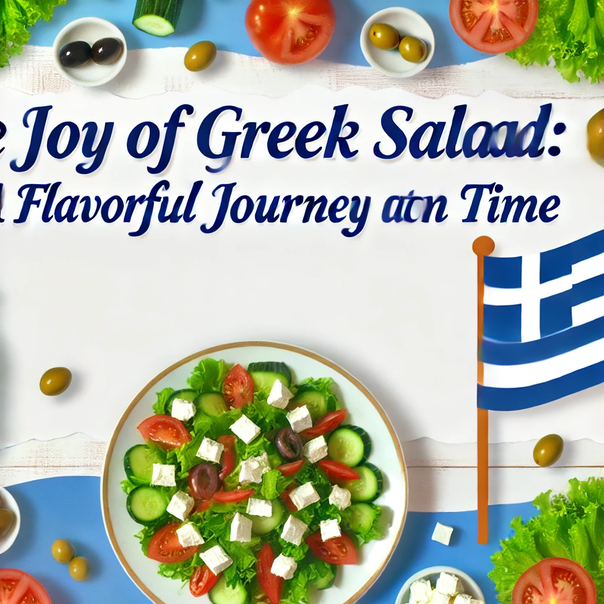
Explore the rich history, evolution, and innovations of Greek Salad, a delightful dish bursting with flavors and vibrant ingredients.
A Flavorful Delight
Greek salad, known as Horiatiki, is more than just a dish; it’s a vibrant representation of Greek culture and culinary tradition. Bursting with fresh ingredients, the salad is a staple in Mediterranean cuisine, celebrated for its simplicity and rich flavors. In this post, we will dive deep into the meaning, invention, history, evolution, and innovative adaptations of Greek salad. Join us on this delicious journey! #GreekSalad #MediterraneanCuisine
The Meaning of Greek Salad: A Culinary Icon
Understanding Horiatiki
At its core, Greek salad embodies the essence of the Mediterranean diet: fresh, wholesome ingredients that come together in a harmonious blend. Typically, a classic Greek salad features ripe tomatoes, crisp cucumbers, red onions, green bell peppers, Kalamata olives, and a generous chunk of feta cheese, all drizzled with olive oil and seasoned with oregano. Each ingredient plays a vital role, contributing not only to the dish's flavor but also to its nutritional value. This salad is a celebration of the earth’s bounty, making it a symbol of health and vitality. #HealthyEating #MediterraneanDiet
The Invention of Greek Salad: Origins and Roots
From Local Tradition to Global Delight
Greek salad has its roots in the rustic cooking of Greece. While the exact origins of Horiatiki are difficult to pinpoint, it likely emerged from the traditional peasant food of the countryside, where locals relied on fresh, seasonal produce. The salad's simplicity reflects the agrarian lifestyle, showcasing the natural flavors of local ingredients.
Interestingly, Greek salad as we know it today gained popularity in the 20th century, particularly during the 1960s. As Greece opened up to international tourism, travelers fell in love with the fresh, vibrant flavors of Horiatiki, leading to its spread beyond the shores of Greece. Today, this salad can be found in restaurants and homes around the world, symbolizing the allure of Greek cuisine. #CulinaryHistory #GreekCuisine
The History of Greek Salad: A Culinary Timeline
From Ancient Roots to Modern Tables
The history of Greek salad is intertwined with the evolution of Greek cuisine itself. Ancient Greeks enjoyed salads that included ingredients such as herbs, vinegar, and olive oil. However, the modern Greek salad began to take shape in the 19th century, influenced by regional ingredients and customs.
During this time, the salad began to incorporate more robust flavors, with feta cheese and olives becoming staples. The rise of tourism in Greece further popularized Horiatiki, leading to variations that catered to international palates while maintaining its authentic essence.
In the late 20th century, Greek salad became a global phenomenon, embraced by health enthusiasts and food lovers alike. Its colorful presentation and nutrient-rich profile made it a favorite among those seeking a wholesome meal. #CulinaryEvolution #GlobalCuisine
The Evolution of Greek Salad: Embracing Change
A Dynamic Dish
Over the years, Greek salad has evolved, adapting to modern tastes and dietary preferences. While the traditional recipe remains beloved, various innovative twists have emerged. Chefs around the world have experimented with ingredients, incorporating elements such as quinoa, grilled vegetables, and even fruit like watermelon or pomegranate for a refreshing twist.
Moreover, as the demand for plant-based options has surged, Greek salad has become a go-to dish for vegetarians and vegans. The use of alternative cheeses, like cashew-based feta, allows those with dietary restrictions to enjoy this iconic dish without compromising flavor.
Interestingly, the rise of health-conscious eating has also led to the incorporation of superfoods, with kale and avocado making appearances in contemporary versions of Greek salad. These innovations keep the dish fresh and exciting while maintaining its roots in tradition. #FoodInnovation #HealthyChoices
Innovations in Greek Salad: A Culinary Adventure
Reimagining Tradition
The world of Greek salad is vibrant and dynamic, with chefs continually finding ways to innovate while respecting tradition. For instance, some culinary experts have embraced molecular gastronomy to create playful interpretations of the classic salad, using techniques like spherification to transform olive oil into tiny pearls that burst with flavor.
In addition, the incorporation of global spices and flavors has allowed Greek salad to transcend its Mediterranean origins. From adding a hint of spice with harissa to infusing it with Asian flavors through sesame oil and soy sauce, the salad has transformed into a canvas for culinary creativity.
Furthermore, the rise of food delivery and meal prep services has made Greek salad more accessible than ever. Pre-packaged versions featuring the essential ingredients allow busy individuals to enjoy a healthy meal without the hassle of preparation. #CulinaryCreativity #HealthyLifestyle
Celebrating Greek Salad
A Timeless Classic
Greek salad stands as a testament to the beauty of simplicity in cooking. It celebrates the vibrant flavors of fresh ingredients and reflects the rich cultural heritage of Greece. As we explore its meaning, invention, history, evolution, and innovations, it’s clear that Horiatiki is more than just a dish; it’s a symbol of joy, health, and togetherness.
Whether enjoyed at a seaside taverna or prepared at home, Greek salad brings people together. So, let’s raise a fork to this delightful creation and embrace the vibrant flavors and nourishing benefits it offers! #CelebrateFood #GreekSaladLove
